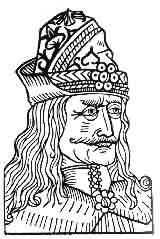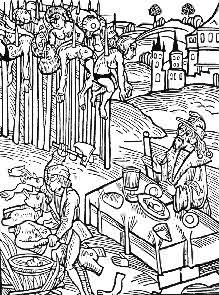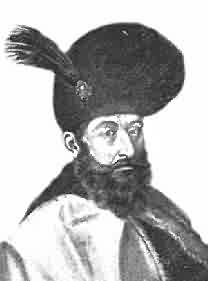
MARCH OF THE TITANS - A HISTORY OF THE WHITE RACE
CHAPTER 36 : THE MELTING POT - ROMANIA, BULGARIA, ALBANIA AND GREECE
Part i - Romania
The history of the Balkans once again follows the pattern of the rise and fall of civilizations according to the composition of the people living in these countries. In the case of Albania, this process is particularly marked, with the effects being less prominent in Romania, Bulgaria and Greece only by the measure of the population change in these regions. All these nations have suffered greatly - and bear the scars - of the Ottomans.
ROMANIA
Romania was, along with its present day neighbors, the site of some of the earliest established Upper Paleolithic and Neolithic cultures in the world, dating from 10,000 BC. The region also bore the brunt of invasions from the east, with the first major wave of invaders being the Indo-European tribes who swept over the land starting about 3000 BC.
DACIA - INCORPORATION INTO THE ROMAN EMPIRE 106 AD
The first Indo-European inhabitants of the region settled in Thrace in Greece, only later moving north. Greek writers refer to the inhabitants of Romania as Getae.
Living in relative peace and obscurity, the Getae were incorporated into the Eastern Roman province of Dacia in 106 AD by the Roman Emperor Trajan.
Roman colonists were sent to Dacia, and they developed the region considerably, building roads, bridges, and a great wall that stretched from what is today the Black Sea port of Constanta to the Danube River - the wall being designed to keep out further incursions by other Indo-European tribes.
This fear of further incursions was well justified. By 250 AD, the Indo-European Goths invaded Dacia and drove the Romans out of large pieces of it. By 270 AD, the Romans had withdrawn the last of their legions from the region, leaving behind however a large number of original Romans who had settled in the area.
The Roman influence - and hence original Roman genes - were so marked that the people of Dacia continued to speak Latin for many years after the official withdrawal of the last Roman legions.
ASIATIC INVASIONS LEAVE THEIR GENETIC IMPRINT
The overwhelmingly Indo-European racial make-up of Romania was however to be disrupted by very nearly 1000 years of Asiatic and Ottoman and even Gypsy invasions.
Nonwhite tribes not only physically decimated the White Rumanians but also left a small but significant segment of clearly Nonwhite or mixed race inhabitants. This includes a large number of Gypsies, some 1.8 million according to a 1992 estimate.
These groupings were however for the greatest part excluded from mainstream Romanian society, although it was inevitable that a small number were taken up into parts of the Romanian population.
The Asiatic invasions and their consequences are detailed in other chapters - suffice to say here that they included the armies of Atilla the Hun, the Avars, Bulgars and Magyars.
SLAV INVASION
The White population of Romania received a boost however when the region was occupied by bands of wandering Indo-European Slavs, who, by the 4th Century had been Christianized and had established that religion in Romania.
Through mixing with the remaining Dacians, the Slavs created a new ethnic grouping known as the Vlachs, a name designating Latin-speakers of the Balkan Peninsula. Romania was then to be occupied by her Slavic neighbors as well - all these movements served to strengthen the White population base once more after the Asian invasions.
FOREIGN OCCUPATION BY HUNGARY CIRCA 1000 AD
In 1003, King Stephen I of Hungary, annexed a large part of what is today Romania. By the 13th Century the Hungarians had invited Germanic tribes, including Saxons and the Teutonic Knights (who were later to rise to prominence in their Christianization of the Baltic region) into Hungary, ostensibly to bolster Christianity, but having the important side effect of once again boosting the White element of Romania's population. The Vlachs were increasingly pushed into the mountainous regions and there established the principalities of Walachia and Moldavia.

Vlad Dracula (circa 1420-1476), the Walachian (in Romania) terror of the Turks. Known as Vlad the Impaler, he used brutal terror tactics against the Turks, impaling tens of thousands of them upon stakes, thereby earning his nickname. His name has also been used in western literature as a vampire - although this is completely unrelated to his real activities. Vlad was eventually killed by the Turks, and his head delivered to the Sultan of Turkey on a platter, as proof that their great White enemy was actually dead.
VLAD DRACULA - TERROR OF THE OTTOMANS
Walachia first had a fight on its hands against the Hungarians - however the rise of the Ottoman Empire during the 15th Century saw the region overrun by the Nonwhite Turks. It was from this time that the famous Vlad Dracula, a prince of Walachia in 1456, emerged to become the scourge of the Turks. For a short while he succeeded in liberating Walachia from the Turks.
Although his name has been appropriated for another completely unconnected use in western literature (as a vampire), Vlad was in fact the terror of the Nonwhite Ottoman Empire for many years, and through his sheer terrorism he inflicted some of the greatest defeats upon the Ottomans during their long reign in the Balkans. Vlad Dracula is also known as Vlad the Impaler - he earned this nickname for his habit of impaling the Turks on stakes. His father had fought the Turks along with the famous Hungarian hero, Janos Hunyadi, and in this way Dracula always kept close contact with the Hungarian court at Budapest.
When Vlad became prince of Walachia, the might of the Turks forced to sign a treaty with the Nonwhites, in terms of which he had to pay 10,000 gold ducats per year and provide a constant stream of White male babies for use in the Janissaries. When Vlad became lax in providing the required White youngsters, armed Turkish units began carrying out raids in Walachian territory. This precipitated a breakdown in the treaty between Vlad and the Turks.
FIRST GREAT IMPALING OF THE TURKS
In 1461, Walachian soldiers took a Turkish fort called Giurgiu near the Turkish center of Nicopolis and slaughtered all the Nonwhites they could find, impaling them on stakes, with the tallest stake being reserved for the Turkish governor of Nicopolis, Hamza Pasha.

A 15th Century woodcut shows the - probably allegorical - scene of Vlad Dracula having a meal amongst the victims of his impaling activities. In one instance he impaled 20,000 Turks - the sight of the massacre so shook an invading Turkish army that they turned back rather than face the man who could do such a thing - even though, ironically, Vlad had learned the impaling trick from the Turks themselves.
Dracula continued along the Danube to the Black Sea, sending a message back to the Hungarian court that "we have killed 23,884 Turks". Accompanying this message, Dracula sent two bags full of Turkish heads, ears and noses to underline his point.
By 1462, the Ottomans had drawn up an overwhelming army of 60,000 men to wipe out the upstart Walachian Prince. The Turks advanced in two parts - half sailed along the Danube River while the other half marched overland through Bulgaria. Dracula's men kept the Turks shadowed along the Danube - when the Turks started disembarking, the Walachians burst upon them from the forest on horseback and drove them back into their boats with the ferocity of the attack. However, Dracula knew that he could not face the Turks in open battle, as he did not have the numbers to defeat the Nonwhites in this manner.
GUERRILLA WAR AND THE IMPALING OF 20,000 TURKS AT TIRGOVISTE
Dracula decided to wage a guerrilla war against the Turks, combining it with a scorched earth policy. Constant raids and food shortages then took their toll on the invading Turkish army. The Turkish Sultan himself barely escaped capture when a Walachian party raided his camp in the Carpathinian mountains overlooking Tirgoviste.
Thousands of Turks were captured and killed in this engagement - and when the Sultan advanced upon Tirgoviste itself, he found a mile long gorge filled with 20,000 impaled Turks.
The brutal display was too much even for the notoriously cruel Turks. They withdrew without joining battle for Tirgoviste, with the Sultan complaining that he could not "win this land from a man who does such things".
Sadly for Dracula, he was then deposed as Prince of Walachia by his brother who was kindly disposed towards the Turks.
After being attacked by his brother's forces, Dracula fled to the Hungarian capital, where he was given refuge. In 1476, he once again became prince of Walachia after invading with a new army.
His reign did not however last long - ambushed outside Bucharest, his headless corpse was found in a swamp. His head was delivered on a platter to the Turkish Sultan at Constantinople - the Nonwhites' final revenge on the White prince who had inflicted so many defeats upon them. Walachia then fell once again under Ottoman rule.
MICHAEL THE BRAVE
Turkish rule continued uninterrupted until the end of the 16th Century, when another Walachian prince, Michael the Brave, led a revolt against the Ottomans and succeeded in liberating Walachia, Moldavia, and Transylvania, uniting these regions for a brief period until 1601. Michael is to this day the national hero of Romania for his part in this uprising and for being the first to combine the three territories that were to form Romania.

Michael the Brave: Romania's White national hero. The Nonwhite Turkish invasion reached during the 15th century. Turkish rule continued uninterrupted until the end of the 16th century, when a Walachian Prince, Michael the Brave, led a revolt against the Ottomans and succeeded in liberating Walachia, Moldavia, and Transylvania, uniting these regions for a brief period until 1601. Michael is to this day the national hero of Romania for his part in this uprising and for being the first to combine the three territories that were to form Romania.
OTTOMANS RECAPTURE MOLDAVIA AND WALACHIA
Michael was however defeated by the Ottomans in 1601. The Nonwhite Turks then established a harsh government over Moldavia and Walachia (with Transylvania going to the Hungarians ) with virtual enforced slavery causing hundreds of thousands of Romanian deaths and forcing many hundreds of thousands of others to flee the country for good.
MOLDAVIA OCCUPIED BY HUNGARIANS, POLES AND TURKS
The Moldavians were first occupied by the Hungarians and the Polish: however, the expanding Turkish Ottoman Empire occupied the territory simultaneously with Walachia. A rebellion against Nonwhite rule was led by the Moldavian king Stephen the Great, who succeeded in driving out the Turks in 1457. By 1504, however, the Turks had reoccupied the area, and exacted the same type of punishing government that they imposed in Walachia, causing the same results - death and a mass exodus of the local population.
RUSSIAN DOMINATION
The rise of Imperial Russia under Tsarina Catherine the Great proved to be Romania's eventual salvation. Declaring Russia to be the protector of all Orthodox Christians, the power of Russia at the time persuaded the Ottomans to allow a measure of autonomy in Walachia and Moldavia. This was to culminate in 1829 when the two regions were to be formally attached to Russia as protectorates. The two regions still were however obliged to pay tributes to the Ottomans - a sort of blackmail to prevent further military intervention.
INDEPENDENCE FROM OTTOMANS
By 1857, the regions of Moldavia and Walachia had built themselves up to the point where they were prepared to declare themselves independent. In that year the two states' legislative bodies (made up out of a limited franchise) voted for political union and independence, creating a state with the name Romania. The Ottomans were only however finally removed as a factor from the Romanian state - after a 500 year occupation - after a Russian-Romanian victory over the Ottomans in the Russo-Turkish War of 1877-78.
THE KINGDOM OF ROMANIA
Romania was finally recognized as an independent country by the major European powers in 1878, and a German prince, Carol I, who had led the Rumanians through a difficult period of conflict, was crowned king of Romania in May 1881, formally creating the Romanian kingdom. The expulsion of the Ottomans from all but a tiny part of the European continent by the early part of the 20th Century, saw Romania involved in two Balkan Wars over territory, neither of which significantly expanded Romanian land area.
WORLD WAR ONE - GAINS TRANSYLVANIA
Initially remaining neutral at the outbreak of the First World War; the Rumanians cunningly entered the war on the side of the Allied powers at the very last minute, hoping to gain territory from the defeat of German and Austria. They were duly rewarded, gaining large parts of the former Austro-Hungarian Empire, including Transylvania, and a part of Russia known as Bessarabia, which the Russians had annexed during their period of dominance in Romania.
THE IRON GUARD
Romania was, like Germany, particularly badly affected by the Great Depression which began in 1929 - and, also like Germany, gave rise to its own right wing party, known as the Iron Guard. Strongly under the influence of Nazi Germany, the Iron Guard soon grew to be one of the largest political groupings in Romania and they were finally appointed to the government in 1939. Romania became an official ally of Germany under the prime ministership of Field Marshal Ion Antonescu.

Field Marshal Ion Antonescu, Prime Minister of Romania from 1940 to 1944. On his left breast pocket he wears a Romanian award, the Order of Michael the Brave. Pro-German, he was dismissed from office by the Romanian king in 1944.
THE SECOND WORLD WAR
When Nazi Germany invaded the Soviet Union in 1941, Romania also declared war on the Soviets. Large numbers of Romanian troops served on the Eastern Front, suffering severe losses during the battle of Stalingrad in January 1943. When the Soviet Army turned the tide and advanced into Romania in 1944, the Romanian King dismissed the Iron Guard government, surrendered to the Soviet Union and declared war on Germany.
COMMUNIST ROMANIA
Under Soviet rule, Romania once again lost the territory of Bessarabia to Russia. By 1947 the Communist Party had been installed as sole rulers in a one party state. As in all Eastern European countries, a process of Sovietization of the society was started, which led to Romania falling behind the West in economic development.
NICOALE CEAUSESCU - COMMUNIST TYRANT
In 1965, Nicoale Ceausescu became leader of Romania, establishing a particularly harsh and uninspired rule which was to last until 1989, when he was arrested in a general uprising and executed in December of that year. A series of interim governments then held office, mostly being made up of ex-Communist party officials. Only in 1996, was a non Communist government elected to office.

September 1991 - Romanian miners storm the parliament building in Bucharest during three days of rioting during which they demanded economic reforms as the economy faltered in its transition from state controlled communism to free enterprise. The demonstrators also demanded the resignation of the government - an event which occurred shortly thereafter.
IMMIGRATION
Romania has had virtually no immigration into the country since the end of the Ottoman Empire - however, the country is by no means racially homogeneous, with a large Gypsy element and small, but significant traces of the Asiatic and Ottoman occupation clearly visible amongst a small number of Rumanians.
Romania experienced significant racial turmoil in the early 1990s. Widespread attacks against the Gypsies in 1991 resulted in thousands fleeing to Germany - most were deported back to Romania the next year.
Click here for Part ii - Bulgaria
or
or
or back to
or
All material (c) copyright Ostara Publications, 1999.
Re-use for commercial purposes strictly forbidden.